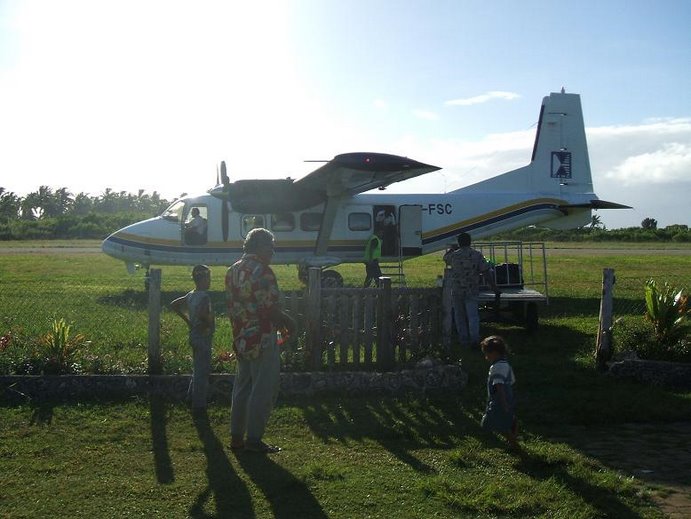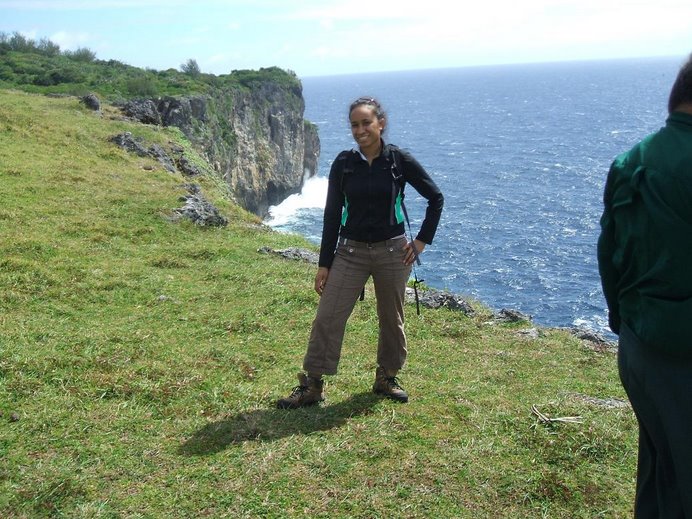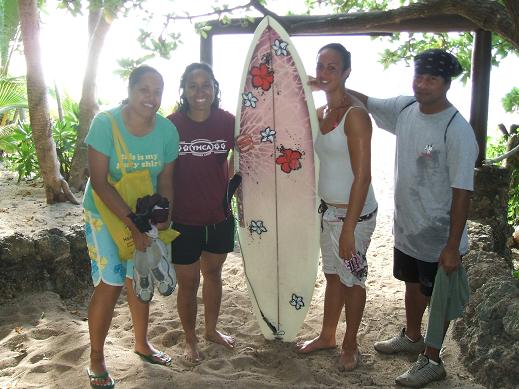
My sister Vina and I during her visit in August
Information from the Tonga Visitors Bureau
Although Nuku’alofa has been the seat of government and royal family for over a century now, legend records that the first Tongan kings ruled from the far Eastern village of Niutoua, where the monumental Ha’amonga (trilithon) stone stands. This trilithon consists of two large vertical stones with a third horizontal connecting stone mortised into the tops of the upright pillars.
These uprights are about 5m high, 4.25m wide and 1.4m thick. The lintel is 5.8m long, 1.4m wide and 0.61m thick. The visible portions of the uprights are estimated to weigh between 30 and 40 tonnes each.

Filo on top of the Ha'amonga.
Ha’amonga Trilithon
The eleventh Tu’i Tonga, Tu’itatui, built the trilithon about 1200 AD. The two uprights are said to represent his two sons, Lafa and Talaiha’apeape, with the lintel uniting the columns symbolizing brotherhood. The Tu’i Tonga was concerned his sons might quarrel after his death and erected the monument as a reminder to stay united. It was they who decided to move the centre of the government to Lapaha. It is said they preferred a more calm anchorage site for their great double-canoes.
Lapaha is the northern district of Mu’a, situated on the shores of a lagoon about 9km east of Nuku’alofa. Because it was the centre of Tongan culture and chiefly rulers for at least six centuries it is the richest area for archaeological monuments in the Kingdom.
Nothing remains of the original living and working quarters of the ancient royal families but a few scattered foundation mounds. However, you can still see the outline of the moat which once encircled the central “kolo” of fortified royal village. (One end of the moat ditch reaches to the present main road next to the large burial mound “Tu’ofefafa”).
During the long reign of the Tu’i Tonga, every village and island was governed by a chief who could trace his descent to the Tu’i Tonga himself. The first known Tu’i Tonga ruled some time about the early ninth century, but the dynasty seems to have reached its peak of power and sophistication about the 15th and 16th centuries, including the reign of Tele’a, whose superb tomb, the “paepae’o-Tele’a,” stands as the finest achievement of ancient Tongan monumental work. By the time Captain Cook arrived in the “Friendly Islands,” in 1780, the dynasty was already degenerating and sixty years after Cook’s visit the Tu’i Tonga was overthrown by the Kanokupolu Chief, Taufa’ahau Tupou I, who went on to found the modern parliamentary monarchy which rules Tonga today.
The power and size of the Tu’i Tonga dynasty can hardly be overstated. Legends and histories from al over the Western Pacific confirm the dominance of the Tongan empire, at the dynasty’s high point. Travelling abroad on their great “kalia” canoes, the Tongans conquered Samoa, the Wallis and Futuna islands, Niue and parts of Fiji.
-- end --
So...what was the downfall of the Tu'i Tonga dynasty? Need to look for another pamphlet on that one.
Later in the pamphlet it said that the Tongans mined the coral lintels from Ha'apai and Paingaimotu (small island off the coast of Nuku'alofa) and transported them to the main island on double hulls. That's cool. No one is making double hulls now in Tonga. Sounds like we need another canoe festival to me.
Great news, the Vava'u Canoe Carving team from the Canoe Festival 2007 has their sights on building a kalia!






1 comment:
I can't believe your cold-hearted attitude towards dogs. You are a mean person. I always question someone's level of compassion if they can't extend it to animals.
Post a Comment